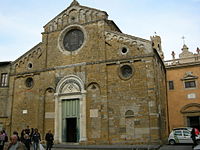Volterra Cathedral
| Volterra Cathedral | |
|---|---|
 |
|
| Basic information | |
| Location | Volterra, Italy |
| Geographic coordinates | Coordinates: 43°24′06.45″N 10°51′31.15″E / 43.4017917°N 10.8586528°E |
| Affiliation | Roman Catholic |
| Province | Pisa |
| Architectural description | |
| Architectural type | Cathedral Church |
| Architectural style | Romanesque |
| Groundbreaking | 12th century |
Volterra Cathedral (Italian: Cattedrale di Santa Maria Assunta, or Duomo di Volterra) is a Roman Catholic cathedral in Volterra, Italy, dedicated to the Assumption of the Virgin Mary. It is the seat of the bishop of Volterra.
The present church was rebuilt after the earthquake of 1117 that destroyed most of the town, and consecrated by Pope Calixtus II in 1120. Details of the earlier church on the site are not clear, although a church dedicated to Saint Mary is known from the 9th century. This was not the original cathedral, which was dedicated to Saint Peter and located next to the bishop's palace; it was destroyed by the Florentines during a siege in 1472, after which the bishop's seat was transferred to the present cathedral.
Nicola Pisano is said to have been involved in further reconstruction in the mid 13th century. The rustic stone façade was built in Romanesque style using spolia from the Roman theater of Volterra in the portal. The intarsia over the door is attributed to Pisano.
In 1580, bishop Guido Serguidi, with the approval of Ferdinando I de' Medici, Grand Duke of Tuscany, commissioned the decoaration of the intricately coffered ceiling of the nave and crossings, designed by Francesco Capriani, carved by Jacopo Pavolini, and gilded by Fulvo della Tuccia. The ceiling has sculpted reliefs of Saints Ugo, Giusto, Pope Linus, Clemente, Attinea, and Greciniana, round a central symbol of the Holy Spirit. The campanile of 1493 replaced an older belltower.
The elongated nave and interior space form a Latin cross. The nave spans 22 columns decorated with stucco simulating rose-colored granite. Much of the interior was restored in 1842-1843. The stucco capitals were completed in the 16th century by Giovanni Paolo Rossetti and Leonardo Ricciarelli. In the 19th century, the walls of the interior were painted in stripes that suggest typical Tuscan decorative church architecture. The floor has tiles of alternating dark and white marble.
...
Wikipedia
